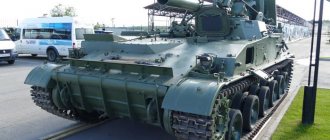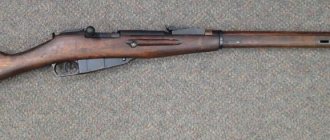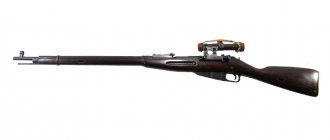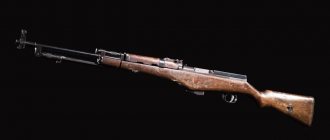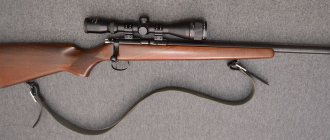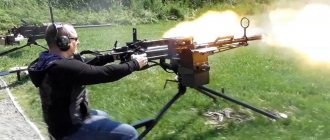More guns, good and different
By the mid-19th century, the greater United States had a very small army. Approximately 15-16 thousand soldiers and officers by European standards were a frankly ridiculous figure - but for a showdown with the Indians this was quite enough, and the United States did not have any other opponents at that moment. And in general, the Americans quite sincerely believed that in peacetime the army was not really needed.
A war will happen, the president will throw out a cry, a people's militia will gather, beat the adversary in the face - and go home.
And then in 1861 the war happened. True, not quite as expected. In any case, the armies of the North and South quickly swelled to hundreds of thousands. And all the soldiers needed at least some kind of weapon.
At the beginning of the war, the standard musket was the Springfield Model 1855 (.58 caliber). In those days it was a completely modern thing - with a rifled barrel and adapted for firing expanding bullets of the Minie system. And there was also a detail familiar to every Soviet boy - a paper tape with caps (actually small copper caps), against which the trigger banged.
Evgeniy Bashin-Razumovsky Expert on historical issues
An expansion-type bullet, also known as a Minie bullet, is cone-shaped, with a notch in the tail, which, under the action of powder gases, expands when fired, pressing into the rifling.
“Springfield” model 1855
This thing was invented by a certain Dr. Maynard, a dentist by profession. Whether he was a friend of Dr. Gatling, history is silent, but, apparently, the American doctors of that time thought a lot about how to reduce the number of patients.
Maynard's tape worked well for toy shootouts. But when the conflict began, it suddenly became clear that sometimes you have to fight in the rain, and in general. So in the next version, Springfield was patched with a normal impact lock.
But even rifles with tape were not enough for everyone - they were made for a small army.
With their brains creaking, the supplies dragged old smoothbore muskets (0.69 inch caliber) from the far ends of the warehouse. These rifles fired round bullets, had a smooth barrel, a flintlock - in general, they shot poorly and not too far. And the army, swelling by leaps and bounds, did not have enough of these reserves.
And then representatives of both warring sides rushed to Europe to buy whatever God would send them.
An excerpt characterizing the Spencer Rifle
“Oh, what a swear word,” he said. - Seasoned, huh? – he asked Danila, who was standing next to him. “He’s seasoned, your Excellency,” answered Danila, hastily taking off his hat. The Count remembered his missed wolf and his encounter with Danila. “However, brother, you are angry,” said the count. – Danila said nothing and only smiled shyly, a childishly meek and pleasant smile. The old count went home; Natasha and Petya promised to come right away. The hunt went on, as it was still early. In the middle of the day, the hounds were released into a ravine overgrown with young, dense forest. Nikolai, standing in the stubble, saw all his hunters. Opposite from Nikolai there were green fields and there stood his hunter, alone in a hole behind a prominent hazel bush. They had just brought in the hounds when Nikolai heard the rare rutting of a dog he knew, Volthorne; other dogs joined him, then falling silent, then starting to chase again. A minute later, a voice was heard from the island calling for a fox, and the whole flock, falling down, drove along the screwdriver, towards the greenery, away from Nikolai. He saw horse-dwellers in red hats galloping along the edges of an overgrown ravine, he even saw dogs, and every second he expected a fox to appear on the other side, in the greenery. The hunter standing in the hole moved and released the dogs, and Nikolai saw a red, low, strange fox, which, fluffing its pipe, hurriedly rushed through the greenery. The dogs began to sing to her. As they approached, the fox began to wag in circles between them, making these circles more and more often and circling its fluffy pipe (tail) around itself; and then someone’s white dog flew in, followed by a black one, and everything got mixed up, and the dogs became a star, with their butts apart, slightly hesitating. Two hunters galloped up to the dogs: one in a red hat, the other, a stranger, in a green caftan. "What it is? thought Nikolai. Where did this hunter come from? This is not my uncle’s.” The hunters fought off the fox and stood on foot for a long time, without rushing. Near them on chumburs stood horses with their saddles and dogs lay. The hunters waved their hands and did something with the fox. From there the sound of a horn was heard - the agreed signal of a fight. “It’s the Ilaginsky hunter who is rebelling with our Ivan,” said the eager Nikolai. Nikolai sent the groom to call his sister and Petya to him and walked at a walk to the place where the riders were collecting the hounds. Several hunters galloped to the scene of the fight. Nikolai got off his horse and stopped next to the hounds with Natasha and Petya riding up, waiting for information about how the matter would end. A fighting hunter with a fox in torokas rode out from behind the edge of the forest and approached the young master. He took off his hat from afar and tried to speak respectfully; but he was pale, out of breath, and his face was angry. One of his eyes was black, but he probably didn’t know it. -What did you have there? – Nikolai asked. - Of course, he will poison from under our hounds! And my mousey bitch caught it. Go and sue! Enough for the fox! I'll give him a ride as a fox. Here she is, in Toroki. Do you want this?...” said the hunter, pointing to the dagger and probably imagining that he was still talking to his enemy. Nikolai, without talking to the hunter, asked his sister and Petya to wait for him and went to the place where this hostile Ilaginskaya hunt was. The victorious hunter rode into the crowd of hunters and there, surrounded by sympathetic curious people, told his exploit. The fact was that Ilagin, with whom the Rostovs were in a quarrel and trial, was hunting in places that, according to custom, belonged to the Rostovs, and now, as if on purpose, he ordered to drive up to the island where the Rostovs were hunting, and allowed him to poison his hunter from under other people’s hounds. Nikolai never saw Ilagin, but as always, in his judgments and feelings, not knowing the middle, according to rumors about the violence and willfulness of this landowner, he hated him with all his soul and considered him his worst enemy. He now rode towards him, embittered and agitated, tightly clutching the arapnik in his hand, in full readiness for the most decisive and dangerous actions against his enemy. As soon as he left the ledge of the forest, he saw a fat gentleman in a beaver cap on a beautiful black horse, accompanied by two stirrups, moving towards him. Instead of an enemy, Nikolai found in Ilagin a personable, courteous gentleman, who especially wanted to get to know the young count. Having approached Rostov, Ilagin lifted his beaver cap and said that he was very sorry for what happened; that he orders to punish the hunter who allowed himself to be poisoned by other people's dogs, asks the count to be acquainted and offers him his places for hunting. Natasha, afraid that her brother would do something terrible, rode not far behind him in excitement. Seeing that the enemies were bowing in a friendly manner, she drove up to them. Ilagin raised his beaver cap even higher in front of Natasha and, smiling pleasantly, said that the Countess represented Diana both by her passion for hunting and by her beauty, about which he had heard a lot.
And who cares about old stuff?!
In Europe, where they also recently re-equipped with modern rifles, American representatives were greeted with open arms - and were immediately handed a mountain of illiquid goods.
The Prussians drove the so-called Potsdam muskets of 1809 to Uncle Sam's agents. The relic that remembered Napoleon had a caliber of 0.70 inches, was heavy, had a sharp recoil, and there were problems with suitable bullets.
Potsdam musket 1809
The Austrians did not lag behind their neighbors, selling Lorenz muzzle-loading rifles - .54 caliber - to the naive Yankees. The French did not pass by either, throwing their 0.57 caliber guns to the anti-slavery fighters.
Are you bending your fingers? Enough for now? Well, we're just getting started.
The Englishwoman - who shits - seemed to sympathize more with the southerners. But feelings are feelings, and business, as you know, is conducted on the principle of “nothing personal.” So Model 1853 Enfields (and .577 caliber) were sold both North and South in huge quantities.
Enfield Model 1853 (photo source)
Of course, in the USA itself, patriotic citizens were not going to stay away from this holiday either.
I'm a patriot, give me money - and more, more!
For example, in the army of the northerners there was a certain General Ambrose Burnside. As a commander, he did not show himself very well, killing up the wall against the southern general Jackson Stone Wall and in general many soldiers against the southern battalions. But the army loved the carbine of his design. It was breech-loading, equipped with a cartridge with a brass sleeve and was much easier to use than the old muzzles. And yes, of course, it had its own special caliber - 0.54. This cartridge was not yet unitary; the capsule had to be inserted separately, which is why misfires often occurred.
Burnside carbine
The Spencer system carbine had a full-fledged unit - one of the first magazine systems for the .56-56 “Spencer Rimfire” cartridge, which was invented by him. True, the gunsmith did not have influential friends and for quite a long time could not push his creation into the army. And I was just unlucky. Either, when demonstrated to Hiram Berdan, the cartridge will explode, or of the two carbines delivered to President Lincoln, one will turn out to be rusty, and the second will be broken by the president himself when trying to shoot...
But Spencer did not lose heart and still managed to put his creation into service. Fortunately, orders for weapons were distributed not only in Washington.
Spencer carbine for .56-56 caliber (photo source)
Hiram Berdan, mentioned above, eventually chose a Sharps rifle for his marksmen - an accurate, long-range rifle with a 0.52 caliber paper cartridge.
Sharps rifle (photo source)
And that was not all.
During the Civil War, only northerners were armed with: Ballard rifles, Colt revolvers, Merrill, Hawken and Allen rifles, Ballard, Joslin, Green, Linder, Merrill, Starr, Warner carbines...
Spencer's 7-charge miracle
Content
Christopher Miner Spencer
Christopher Miner Spencer was one of the inventors of the 19th century, the Edison era, as this time is called in the United States. He was interested in almost everything that personified progress at that time. For example, in 1861, he assembled a steam car in Connecticut and drove it around the neighborhood until local residents complained about him, and he was forbidden to appear in public places on this device.
Over the years, Spencer received many patents, including a textile marking machine, an automatic lathe, and even a pump-action shotgun. But he entered the pantheon of inventors thanks to the carbine that received his name, the Spencer carbine.
The Spencer carbine was one of the best examples of firearms of its time, which it remained for many years.
Christopher Spencer was born in 1833 and began his development as a mechanic at Cheney Brothers. In addition to this company, Spencer had the opportunity to work at other enterprises, including the Colt enterprise, where he was engaged in the production of revolvers.
However, after some time he returned to Cheney Brothers, where he was promised the position of manager. It was then that Spencer began creating a carbine of his own design. The Cheney brothers, owners of the company of the same name, allowed him to use the company's resources for inventive needs, but only during non-working hours.
Invention of the lever shutter
Rocking bolt with a lever-trigger guard The result of Spencer's efforts was the receipt of a patent for a rocking bolt with a lever-trigger guard on March 6, 1860. This mechanism ensured the supply of a rimfire cartridge from a tubular magazine in the butt of the carbine into the chamber.
How the Spencer carbine works
The carbine with the Spencer mechanism turned out to be simple and reliable and can safely be called a repeating carbine thanks to the tubular magazine that held seven cartridges, and the magazine itself was installed in the butt. To feed a cartridge into the chamber, it was necessary to set the trigger in a safe position and use the lever to feed the cartridge. Then cock the hammer, aim and fire.
After shooting all the cartridges, it was necessary to set the trigger again in a safe position (this was required by the conditions for safe handling of weapons) and release the lever. Thanks to these actions, the last fired cartridge case was removed from the chamber, which was finally removed with the fingers. After installing the next magazine, by moving the lever-turning block, a fresh cartridge was again fed into the chamber.
Spencer carbine during the American Civil War
Soon production was organized at the Cheney brothers factory and Spencer's Arms began producing carbines. Early models were sporting-hunting carbines in .36 and .44 caliber, but there was a prototype for the military in .44 caliber.
With the outbreak of the Civil War, Spencer made attempts to interest the military in his carbine. It is worth recalling that at that time the main weapon of the American infantry was the Springfield muzzle-loading rifle, but many militias, volunteers and other paramilitary forces were armed with even more archaic weapons. The situation was somewhat different in the cavalry, where in addition to muzzle-loading weapon models there were also a number of non-magazine breech-loading rifles.
Military officials in the initial period of the war (it was assumed that the war would last some six months) spent a lot of effort and money looking for replacements for this assortment of rifles and muskets.
The original Spencer carbine bolt (left) and its modern counterpart In mid-1861, Spencer demonstrated his carbine to the military in Washington, after which the Department of the Navy ordered 700 Spencer carbines (with bayonets). Spencer, however, independently produced another 300 carbines, in order to increase the economic efficiency of production. After the carbine appeared in the army, American soldiers on foot and on horseback began asking to see the carbine in action.
Soon the first orders began to arrive. Many military personnel, without waiting for the carbines to arrive in the troops, privately purchased a new carbine.
Comparison of the Spencer carbine with other examples
During the war, the caliber of the .56-56 Spencer carbine cartridge was finally formed; the cartridge weighed 23 grams and was loaded with black powder weighing 3 grams, which gave the bullet an initial speed of 365 m/sec and a muzzle energy of 1525 J.
Spencer Carbine Front Sight For comparison, a standard .58 caliber Springfield muzzleloader fired ammunition containing 3.8 grams of powder and equipped with a 32 gram bullet that developed a speed of 289.5 m/s and had an energy of 1355 Joules. Breech-loading carbines of that period had similar characteristics. For example, the Sharps carbine fired a 30-gram bullet, which developed a speed of 305 m/s and had an energy of 1491 J.
With comparable ammunition characteristics, the Spencer carbine had one important advantage: the carbine loaded faster and fired at a higher rate of fire than the rifles described above.
Reviews from the front
Praise came from the battlefields. Initially, most of the carbines were received by the cavalry, but their high combat qualities led to the fact that carbines began to be supplied to other types of troops.
Spencer Carbine Adjustable Sight One of the most successful uses of the Spencer repeating carbine was at the Battle of Gettysburg. During this battle, the northerners fought under the leadership of General George Gordon Meade, and the southerners fought under the leadership of Robert E. Lee. The 5th and 7th Michigan Cavalry, armed with Spencer's carbines, achieved undying glory when, through bold and decisive action, they thwarted the efforts of General Stuart's Virginia Cavalry to break through to the supply trains.
Letters of gratitude were sent to Spencer, who had moved to Boston, Massachusetts, in 1863. Notable among these letters is one poignant letter from Colonel John Wilder describing Spencer's use at the Battle of Chickamauga. Here is a short excerpt from the letter.
“...Now it’s a pity that we had to kill so many people. They fell in heaps, and my heart burned with the desire to stop shooting. But the merciless seven-shot Spencer did not stop..."
From left to right: original .56-56 caliber, .56-50 caliber, shot cartridge, modern .56-50 caliber cartridge
Spencer Carbine and President Lincoln
Despite the fact that the Spencer carbine was already present on the battlefield, Spencer was unable to conclude a large contract with the government for the supply of the carbine. Having decided to receive the contract, Spencer met with President Lincoln on August 18, 1863, taking his carbine to the meeting for a visual demonstration.
According to Spencer himself, Lincoln was impressed and asked the inventor to show the carbine and explain the operation of its mechanism. After Spencer reassembled the carbine, Lincoln suggested they meet again the next day and shoot the carbine.
Arriving right on time, Spencer found himself in the company of President Lincoln and his son Robert, with whom he went to the demonstration site. After waiting for some time for Secretary of War Edwin Stanton - who never showed up for the demonstration, citing being busy - the shooters began testing.
As Spencer later admitted, he shot more accurately than the president, since he practiced almost every day. In justification, Lincoln referred to Spencer's youth and, accordingly, the clarity of his eyes and the firmness of his hands.
Lincoln kept the carbine with him, and the next day, taking his secretary John Hay, he went out to shoot again. Hay was delighted, declaring that "this is a wonderful carbine, incredibly easy to use, which allows you to install the magazine and fire in less than half a minute."
First contracts
As they say, arrogance is the second happiness, and Spencer’s assertiveness paid off with the trio. The War Department issued an order for Spencer repeating carbines, and by the end of the war, about 54 thousand carbines were produced. Carbines were originally manufactured by Spencer and then by the Burnside Rifle Company of Providence, Rhode Island. As a result, the carbine became second, second only to the Sharps rifle in terms of the number of copies produced. In total, over 200 thousand Spencer carbines were produced.
Spencer carbines turned out to be very popular and were used extremely intensively. As a result, it is almost impossible to find these carbines in pristine condition today.
Case of Erastus Blakeslee
Case for magazines for the Spencer carbine Separately, it is worth mentioning the invention of Erastus Blakeslee, which was intended specifically for the Spencer carbine. The invention was a case that made it possible to carry from 10 to 13 seven-round tubular magazines for a carbine. Thanks to this case, the reloading speed increased. However, military personnel complained about the inconvenience of such a case. The case model, designed for 13 magazines, weighed over 4 kilograms, which was more than the weight of the carbine itself.
Post-war period
After the war, Spencer continued to supply carbines to the cavalry, where they eventually replaced the Springfield rifles. The carbine caliber was reduced, and many of the carbines that served in the Civil War were modified at Springfield Armory. The result of the modernization was the use of .56-52 and 56-50 caliber rimfire cartridges in the carbine, which were practically interchangeable.
The trigger guard travel limiter is located in front of the trigger. The carbines were also equipped with a small lever in front of the trigger, which, when moved back, prevented complete movement of the lever guard. This allowed the carbine to be used as a single-shot rifle, keeping the magazine loaded with seven rounds until the most critical moment. The 1865 Spencer model carbine was manufactured by the Burnside Rifle Company for the US government, but some of the carbines were shipped to Canada. 3,000 Model 1867 carbines and 2,500 Model 1868 carbines were also produced.
The Spencer carbine proved to be in demand in other conflicts, including Mexico and even France, where thousands of carbines served in the Franco-Prussian War (1871). A number of carbines were manufactured under contract in Belgium.
In addition to military use, the Spencer carbine was widely used as a sporting and hunting rifle in a variety of calibers and with a variety of embellishments and finishes. Today they are still valuable and in demand.
Interest in the Spencer carbine increased somewhat in the 20th century after its appearance in the film “Unforgiven” with the participation of Clint Eastwood. Their popularity has led to the fact that today a number of companies produce them in .56-50, .45 Colt and .44-40 calibers. After the end of the American Civil War, Spencer faded into obscurity and relatively little is known about his life, but it is known that at the age of 81 he flew over the forests of New England, piloted by his son. Spencer died in 1922.
Logistician's nightmare
In total, during the Civil War, more than three dozen different types of small arms were adopted by the US Army. This whole hodgepodge required an individual approach - in the sense of a different cartridge for each rifle. At the same time, a regiment with the latest “Spencers” at the front could be located next to a brigade that had old muzzle-loading muskets with paper cartridges.
History has not exactly preserved what the suppliers, and even the soldiers themselves, said about this. Maybe the paper couldn’t stand it, maybe something else happened….




